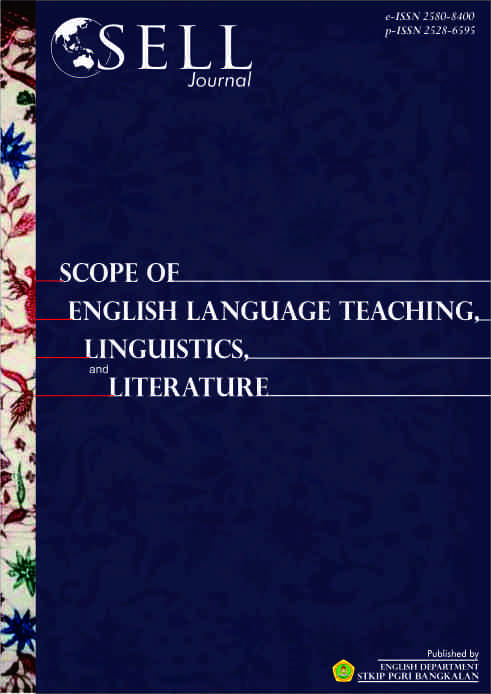The Implementation of Authentic Assessment in Speaking Tests for Secondary School Students
DOI:
https://doi.org/10.31597/sl.v10i2.1231Keywords:
Authentic Assessment, SpeakingTest, SecondarySchool, EnglishLanguageTeachingAbstract
The use of authentic assessment in speaking tests has gained greater significance to close the gap between theory and practice in the classroom. Although its value in measuring actual language skills in everyday life is known, its effective implementation by teachers remains a problem and inconsistencies in measuring students' speaking skills are the result. This study aims to explore the implementation of authentic assessment in speaking tests in SMA Negeri 5 Pamekasan, namely the implementation processes employed by teachers and the impact towards the students' actual speaking abilities. Conducting a qualitative descriptive study, data were collected using interviews, observation, and documents to represent the naturalistic nature of the classroom and the teachers' assessment strategies. The study reveals that SMA Negeri 5 Pamekasan teachers have informal and formative tests that involve reading aloud, pronunciation, intonation, and confidence measures in classroom interactions. Question-answer and reading aloud are some of the strategies used to overcome the students' shyness to speak and judge more realistically their communications. The study concludes that authentic assessment, when properly understood and implemented, exactly measures students' speaking skill under actual circumstances and helps teachers know how to direct further improvement. This study provides implications and pedagogical suggestions for teachers to enhance authentic assessment practice in English speaking courses.
References
Abdussamad, Z. (2021). Metode Penelitian Kualitatif (1st ed.). CV.Syakir Media Press.
Afriadi, Z., Arifuddin, A., & Nuriadi, N. (2021). The Implementation of Authentic Assessment in Speaking Skills at MTS As-Suyuthy Ireng.
Ary, D., Jacobs, L. C., Razavieh, A., & Sorensen, C. K. (2010). Introduction to Research in Education. Belmont: Wadsworth Cengage Learning.
Brown, H. D. (2004). Language Assessment: Principles and Classroom Practices. Pearson Education.
Chandra Alam, A., Tauhidin Abas, T., & Saefullah, H. (2024). Teacher’s Beliefs And Practices Of Authentic Assessment In EFL Speaking Classes: A Case Study. Jurnal Ilmiah Wahana Pendidikan, 10(7), 183–192. https://doi.org/10.5281/zenodo.11055136
Creswell, J. W. (2012). Educational Research: Planning, Conducting, and Evaluating Quantitative and Qualitative Research. Pearson Education.
Farizi, F., & Herwiana, S. (2022). A Study of Teaching Speaking Techniques Used at Peace English Course Pare, Kediri. Pioneer: Journal of Language and Literature, 14(1), 43. https://doi.org/10.36841/pioneer.v14i1.1382
Firdausi, W. (2024). Teachers’ Implementation of Authentic Speaking Assessment: A Case Study of Senior High Schools in Ambon. Huele: Journal of Applied Linguistics, Literature and Culture, 4(1).
Hernández-Ocampo, S. P., Chala-Bejarano, P. A., & Rodríguez-Uribe, M. (2025). Pre-service english teachers’ perceptions of language assessment in a colombian language teacher education program. International Journal of Educational Research Open, 8(November 2024). https://doi.org/10.1016/j.ijedro.2024.100405
Khonbi, Z. A., & Sadeghi, K. (2013). The Effect of Assessment Type (Self Vs. Peer) on Iranian University EFL Students’ Course Achievement. Procedia - Social and Behavioral Sciences, 70, 1552–1564. https://doi.org/10.1016/j.sbspro.2013.01.223
Kuo, Y. S., Wang, S. I. C., & Liu, E. Z. F. (2025). Peer assessment using one-to-one tablets to improve the English oral presentation of fourth-grade students in Taiwan. Computers and Education Open, 8(July 2024), 100262. https://doi.org/10.1016/j.caeo.2025.100262
Kurnia Putri, I., & Zaim, M. (2019). Developing Instrumens For Evaluating The Implementation Of Authentic Assisment For Speaking Skiil At Junior High School.
Leong, L.-M., & Ahmadi, S. M. (2017). An Analysis of Factors Influencing Learners’ English Speaking Skill. International Journal of Research in English Education, 2(1), 34–41. https://doi.org/10.18869/acadpub.ijree.2.1.34
Made, N., Anggreni, D., Dantes, N., & Candiasa, M. (2014). Pengaruh Model Pembelajaran Master Dan Aesmen Autentik Terhadap Hasil Beajar IPA siswa Kelas VIII SMP Negeri 1 Payangan (Vol. 4).
Rahmawati, Y., & Ertin. (2014). Developing Assessment for Speaking Yenny Rahmawati & Ertin. Indonesian Journal of English Education, 1(Syarif Hidayatullah State Islamic University of Jakarta), 199–210.
Rao, S. P. (2019). The Importance of Speaking Skills in English Classrooms. Alford Council of International English & Literature Journal(ACIELJ), 8(5), 55.
Souzandehfar, M. (2023). New Perspectives on IELTS Authenticity: An Evaluation of the Speaking Module. International Journal of Language Testing, 14(1), 34–55. https://doi.org/10.22034/IJLT.2023.409599.1272
Sukarno, S., Fitrianingsih, I., Pratiwi, D., & Putro, N. H. P. S. (2023). Pre-service English teachers’ perception of authentic assessment practice in speaking classes. LITERA, 22(1), 107–115. https://doi.org/10.21831/ltr.v22i1.58864
Tabi, I., Mursyida, ul, Faridi, A., Utara, K., & Pascasarjana UNNES, K. (2020). English Teachers’ Perception and Implementation of Authentic Assessment for Speaking Based on 2013 Curriculum. http://journal.unnes.ac.id/sju/index.php/eej
Ukashatu, A. (2021). Emerging Issues in Educational Measurement: Authentic Assessment. JISAE: Journal of Indonesian Student Assessment and Evaluation, 7(2), 73–80. https://doi.org/10.21009/jisae.v7i2.23056
Wafi, A., Febrianingrum, L., & Rahmawati, F. (2025). Unveiling English Speaking Competence : A Portrait of First- Semester Students in the Foreign Language Development. 7(1), 124–143. https://doi.org/10.19105/panyonara.v7i1.16731
Zhang, H., Ge, S., & Mohd Saad, M. R. Bin. (2024). Formative assessment in K-12 English as a foreign language education: A systematic review. Heliyon, 10(10), e31367. https://doi.org/10.1016/j.heliyon.2024.e31367

Downloads
Published
How to Cite
Issue
Section
License
1. Copyright of this journal is possession of Editorial Board and Journal Manager, by the knowledge of author, whilst the moral right of the publication belongs to the author.
2. Legal formal aspect of journal publication accessibility refers to Creative Commons Atribution-ShareAlike (CC BY-SA), implies that this license lets others remix, adapt, and build upon your work even for commercial purposes, as long as they credit you and license their new creations under the identical terms. This license is often compared to “copyleft” free and open source software licenses.
3. Every publications (printed/electronic) are open access for educational purposes, research, and library. Other that the aims mentioned above, editorial board is not responsible for copyright violation














